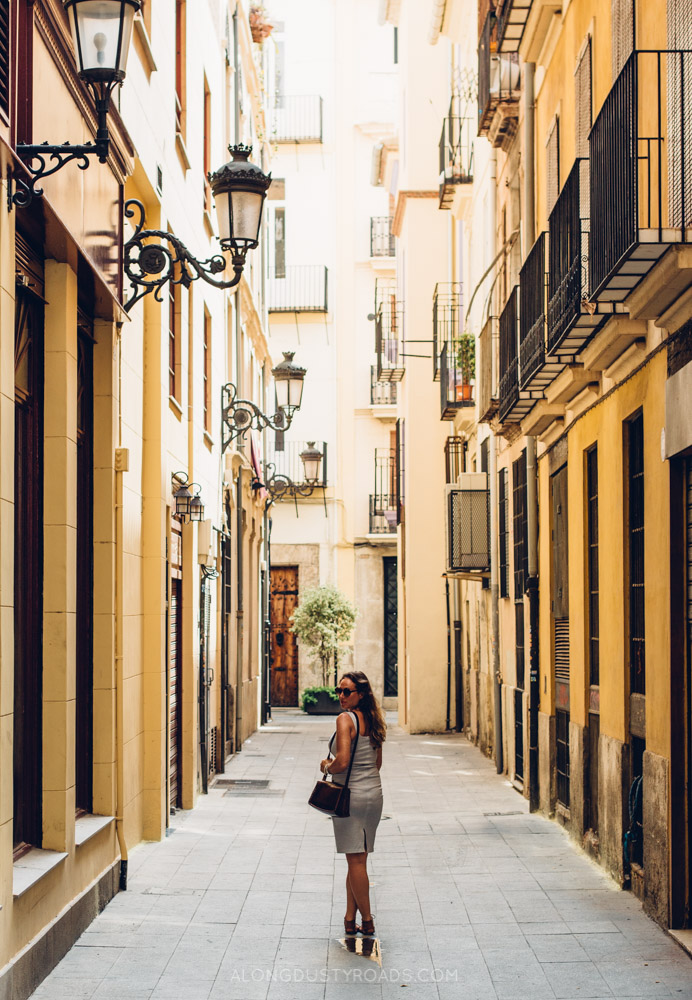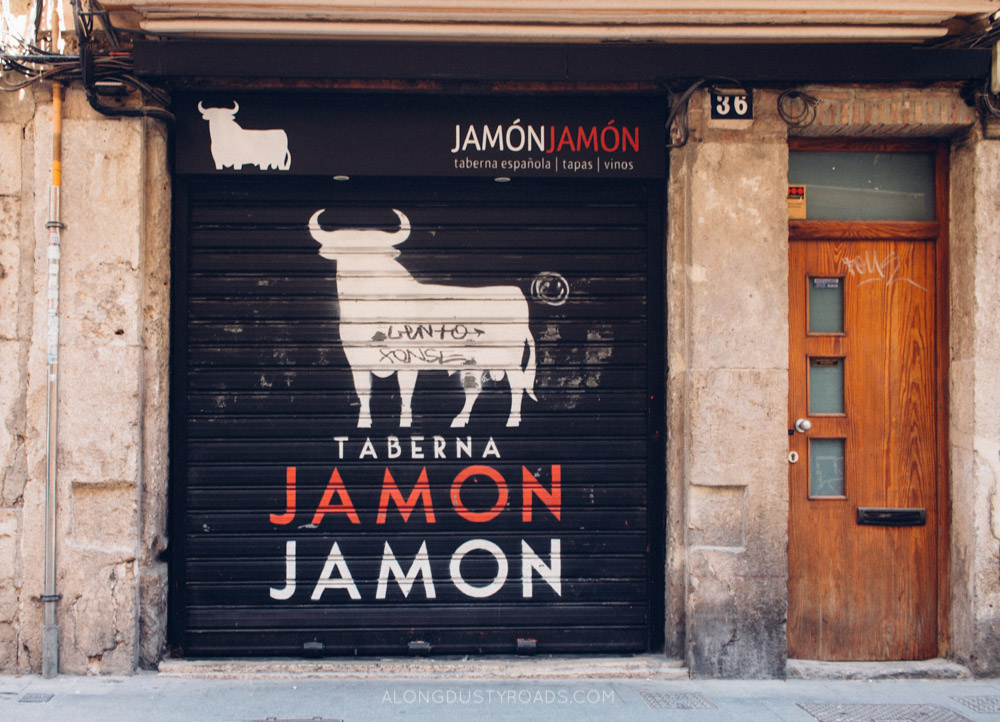We've already told you all the things to do in Valencia which make it a great location for your next holiday (especially for foodies), but to help you prepare for the perfect Spanish escape, we wanted to share some very useful things to know before your visit to Spain's third-largest city.
it has a language all of its own
We arrived in Valencia excited to practice our Spanish - but what we heard in certain places sounded a lot more like Portuguese, and looked a little more like French! As it turns out, the bulk of people born and bred here speak Valenciano*.
Confusingly for the visitor, this means you will often see 'Carrer' rather than 'Calle' (street), 'Plaja' in place of 'Playa' (beach) or 'Mercat' not 'Mercado' (market) on signs or bus timetables. The reason that any new signs will contain the Valenciana word, whilst old ones will have the Spanish? During the Franco-era, Valenciana was banned in public spaces and streets and monuments with were given Castilian names instead, with public use of the language severely frowned upon and often punished. It wasn't until 1983, six years after democracy arrived in Spain, that the official use and the teaching of the language was restored. Since then, there has been concerted effort to revitalise the usage and visibility of the language in the public and private sphere.
The only thorny issue? We still haven't found a definite answer if Valenciana is a dialect of Catalan or a language all of its own - and you will receive some very different (and strong opinions) on the matter from people in the city. Linguistic identity is inextricably linked with culture, politics and regional pride here, so don't underestimate how passionate or defensive some may get.
*If you do speak Spanish, you'll be relived to know that it's still a language everyone knows and you'll have no issues communicating with locals, but may struggle to pick up the odd word or phrase.
Read More | Find out how we learned spanish for PRACTICALLY nothing
you should stay in the city centre
As it's a coastal city, you may think that you should stay by the sea? Well, we're here to advise you that that would be a bad call.
There are a lot of amazing condo-type villas or apartments by Malvarossa beach but, we think you're much better off staying central so that you can pick and choose between a beach day or a bit of old town exploration without too much inconvenience. Also, the best beaches in Valencia are actually accessed via a bus which leaves from the city centre, so you don't want to be too far away from that (find out our favourite beaches in Valencia and how to reach them)
We spent a night at the Valencia Lounge Hostel, which we highly recommend, before moving into our AirBnb near Plaza Espanya and Xativa (an area we really liked).
Other popular spots to stay are Russafa (Ruzafa), the hipster district, or the old town (Ciutat Vella), the area where the vast majority of hostels and apartments are located - although, don't worry if it's a little out of your budget or you can't find something you like. Valencia is a pretty small city so, as long as you're based centrally, you're never too far from anything on foot or with public transport.
We’ve covered accommodation options in much more detail (with our top picks for hostels, hotels and airbnbs) in our ‘Things to Do in Valencia’ post, so if that’s what you’re after be sure to head over there!
It's the real home of paella
Don't believe what anyone else may tell you; paella originally comes from Valencia and nowhere else. This is another fierce point of pride for Valencians and they will only be too happy to tell you that how we all enjoy and consume paella in the UK is an absolute abomination. As you're probably beginning to pick up already, Valencians are a proud people unafriad to express themselves.
On the plus side, this means there are some fantastic, authentic spots in the city to enjoy the rice-based dish, as well as some excellent cooking classes where you can learn about the culture and traditions surrounding paella as well as feast upon it (straight out of the pan of course, in true Spanish style).
If you'd like a thorough introduction to the city's foodie scene, consider this highly rated culinary tour - and be prepared to eat EVERYTHING!
the airport is easily accessible
There is only one airport serving Valencia, and it's thankfully quick, easy and cheap to make your way from there to the city centre as it's only 8 kms away.
You can either take:
1) Metro lines 3 or 5 for around 20 minutes, exiting at Xativa or Colon. This costs €3.90, but is included within the unlimited transport on the Valencia Tourist Card, so we recommend having an idea if you want to buy the card before you hop on the metro - or buy it in advance here.
2) The Aero-Bus leaves every 15 minutes from outside the terminal. The cheaper city bus (Number 150) also runs to the city centre, with more stops along the way than the Aero-Bus, but costs only €1.50 per person.
For a full breakdown of the transport options to/from Valencia airport, including costs and operating times, read this.
It has a slightly confusing transport network
Having both lived in cities with extensive undergrounds, it took us a little while to understand the point of Valencia's. That is, until we properly studied the map.
Turns out, the metro here is actually not very useful for getting around the city, but is excellent for reaching further away suburbs (or the airport) - and it looks like it was planned this way.
So, if you want to navigate the city centre, then you're much better off taking the bus. Just remember, that they run a circular route - this means that it doesn't drop off and pick-up at the same spot i.e. the bus we took to the old town from just outside our door didn't stop anywhere near us on the return journey. You may need to, like us, ask a few locals to direct you to the right stop.
Fundamentally, the public transport in Valencia is of a really good standard and is clean and modern; we just found certain aspects of its organisation a little odd for the first few days.
Useful resources | The EMT website has a route planner and a very useful (although not always entirely clear) overview of ticket prices and the various types of travel cards recommended for visitors to the city (link in English). You can buy and top-up the card at a variety of places, but we'd recommend just heading straight to the nearest metro's ticket office. The options, on first read, can be a little confusing but it basically can be split into those which give you 10 journeys for a small discount on the bus, or a combination of bus or metro, and those that give you unlimited travel and connections on both the bus and metro for a defined period of time.
As we were there for two weeks, we went for a combination of the Valencia Tourist Card - which gave free access to certain sights and discounts, as well as unlimited transport for 1-3 days - and a Bono Travel Card. In terms of the best tool for navigating the city's transport system? Then look no further than Google Maps, which we'd also recommend you store off-line during your visit so you always have a handy map with you.
As with many other European cities, Valencia now has a bicycle rental scheme called Valenbisi, which is a great option for those who prefer two wheels.
The importance of the siesta
In the summer months, opening hours aren't necessarily conducive to a tourist's itinerary, and the afternoon siesta is taken very seriously. Whilst this is great for those that enjoy an afternoon nap, for the uninitiated, this will inevitably result in at least one afternoon spent wandering around, wondering where all the Spaniards are and why nothing is bloody open!
So, it's good to know before you go that a number of shops and restaurants shut between 2 pm and 6 pm, with a number not opening at all in the height of summer as they've buggered off on their own holiday.
We guess we can't blame them, we'd rather be at the beach in August than working!
It hardly ever rains
Ok, so it did rain when we visited. But, the shock on locals' faces - and their insistence that this was a really bizarre event - confirms that Valencia really does not suffer from too much drizzle. The average temperature in the city rarely drops below 10°C, even in winter, which explains why it's such a popular destination all year round – especially as there is a guaranteed minimum of 8 hours of sunshine per day. If you're not visiting in summer, then check out the likely weather conditions here.
book ahead for march
The five-day 'Las Fallas' festival (which actually runs for more like two weeks) sees hundreds of huge puppets are paraded on the streets before being torched. It takes place in March each year and is becoming more and more popular. So, expect less availability and increased rates. Find out more about the festival, its origins and key dates here.
Consider a Valencia Tourist card
It does seem a little like every city touts their own 'money-saving tourist card' but often they rarely seem to be terribly useful. The Valencia Tourist Card however is quite the opposite.
Combining free public urban transport (including to and from the airport) and free entrance to public museums, it also provides discounts of up to 25% on tours services and money-off offers in shops and restaurants.
Cards can be bought in 24, 48 and 72 hour bundles. Check prices and buy yours here.
It's not too expensive
Despite the British Pound rapidly declining in value before we travelled (gracias Brexit), we were actually pleasantly surprised at how far our money could stretch. The public transport is really reasonably priced (less than €1.50 a journey if you buy a travel card), drinks out didn't cost the earth whilst shopping at our local Mercadona supermarket was insanely cheap (especially for booze and fruit/veg).
top tip: The menú del dia, served only at lunchtime, is a good budget way to dine out every now and again. Offered by most restaurants, it offers 2 to 3 courses of a set-menu, including a drink, for around €10.
It has amazing beaches
We knew Valencia had beaches, but what we didn't realise is quite how amazing they are! Just thirty minutes from the city centre, even in the height of summer, you can find stretches of beautifully sandy beach with only a handful of people sharing it with you, even in peak summer.
For those wanting to escape the hordes of Brits and Europeans that flock to Spain's more popular beaches, Valencia is an excellent alternative. And, if you want to try a bit of full nudity sunbathing (and we mean FULL nudity), then this is the place to give it a go...
You can fly to Ibiza in half an hour
We're telling you this for two reasons:
1) After much stressing out for hours, it transpired that we could save 50% on the cost of our flights by taking Ryanair to Ibiza and then catching a connection back to London.
2) Lots of locals head to Ibiza to party for the weekend or to have a break from the city - if you can find a cheap flight too, then it might be worth looking into.


























